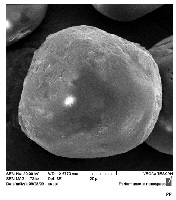Factorial effect of process parameters on pharmaceutical characteristics of biodegradable PLGA microparticles
Keywords:
Furosemide, PLGA microparticles, Full factorial designAbstract
Among the drug delivery strategies intended to increase the bioavailability of drugs, the use of polymeric biodegradable microcarriers has shown a significant degree of success. The purpose of this study was developing a polymeric drug delivery system for a model drug: furosemide, which belongs to class IV of BCS (low solubility and low permeability), intended to oral administration and improving the stability and intestinal absorption of the drug. To achieve this goal, furosemide loaded poly (lactic-co-glycolic acid) (PLGA) microparticles were prepared by solvent evaporation method and characterized. To obtain an appropriate mathematical model with minimum experiments for optimization of formulation, a 24 full factorial design based on four independent variables (amount of polymer, emulsifier, volume of internal and external phases) was used to plan the experiments. The effects of these parameters on the drug loading efficiency were investigated. The release profiles of furosemide from microparticles were examined in simulated gastric fluid (SGF pH 1.2), simulated intestinal fluid (SIF pH 7.4) and phosphate buffer (pH: 7.4). The results of optimized formulation showed a narrow size distribution with an average diameter of 60 ± 5 µm and a drug loading of more than 60%. In simulated gastric fluid (SGF), less than 8% of furosemide was released from microparticles in 24 h and about 60% and 50% furosemide was released in 24 h in simulated intestinal fluid (SIF) and phosphate buffer, respectively. Results from this preliminary work showed that furosemide loaded PLGA microparticles can be successfully obtained through solventevaporation technique, with good morphological characteristics, high encapsulation efficiency and controlled drug release profile suitable for per oral administration.
References
Aceves JM, Cruz R, Hernandez E.
Preparation and characterization of
Furosemide-Eudragit controlled release
systems. Int J Pharm. 2000;195:45-53.
Beyers H, Malan S, Van der watt JG, De
villiers MM. Structure–solubility
relationship and thermal decomposition of
furosemide. Drug Dev Ind Pharm.
;26(10):1077-1083.
Hua A, Jones SA, Villiers MMD, Lvov
YM. Nano-encapsulation of furosemide
microcrystals for controlled drug release. J
Control Rel. 2003;86:59-68.
Flanagan ShD, Benet LZ. Net secretion of
furosemide is subject to indomethacin
inhibition, as observed in caco-2 monolayer
and excised rat jejunum. J Pharm Res.
;16:221-224.
Bundgaard H, Noorgaard T, Nielsen NM.
Photodegradation and hydrolysis of
furosemide and furosemide esters in
aqueous solutions. Int J Pharm.
;42:217-224.
Haznedar S, Dortunc B. Preparation and in
vitro evaluation of Eudragit microparticles
containing acetazolamide. Int J Pharm.
;269:131-140.
Li M, Rouaud O, Poncelet D.
Microencapsulation by solvent evaporation:
State of the art for process engineering
approaches. Int. J. Pharm. 2008;363(1-
:26-39.
Dawes GJS, Fratila-Apachitei LE, Mulia K,
Apachitei I, Witkamp G, Duszczyk J. Size
effect of PLGA spheres on drug loading
efficiency and release profiles. J Mater Sci:
Mater Med. 2008. DOI: 10.1007/s10856-
-3666-0.
Zhang X, Wiss U, Pichora D, Goosen MFA.
A mechanistic study of antibiotic release
from biodegradable poly (D, L-lactide)
cylinders. J. Control. Rel. 1994;31:129-144.
O’Hara P, Hickey AJ. Respirable PLGA
microparticles containing rifampicin for the
treatment of tuberculosis: Manufacture and
characterization. J. Pharm. Res.
;17(8):955-961.
Kompella UB, Koushik K. Preparation of
drug delivery systems using supercritical
fluid technology. Crit. Rev. Ther Drug
Carrier Syst. 2001;18(2):173-199.
Vandervoort J, Ludwig A. Biocompatible
stabilizers in the preparation of PLGA
nanoparticles: a factorial design study. Int J
Pharm. 2002;238(1-2):77-92.
O’Donnell PB, McGinity JW. Preparation
of microspheres by the solvent evaporation
technique. Adv Drug Delivery Rev.
;28:25-42.
Derakhshandeh K, Erfan M, Dadashzadeh
S. Encapsulation of 9- nitrocamptothecin, a
novel anticancer drug, in biodegradable
nanoparticles: Factorial design,
characterization and release kinetics. Eur J
pharm Biopharm. 2007;66:34-41.
Gohel M, Amin A. Formulation
optimization of controlled release
diclofenac sodium microparticles using
factorial design. J Control Rel. 1998;51(2-
:115- 122.
Mayank D, Sandip B, Mansoor M.
Formulation optimization for the
nanoparticles-in-microsphere hybrid oral
delivery system using factorial design. J
Control Rel. 2006;110:422-430.
Mathew ST, Devi SG, KV S. Formulation
and Evaluation of Ketorolac Tromethamineloaded Albumin Microspheres for Potential
Intramuscular Administration. AAPS
Pharm Sci Tech. 2007;8(1):Article 14.
Rawat M, Saraf Sh, Saraf S. Influence of
Selected Formulation Variables on the
Preparation of Enzyme-entrapped Eudragit
S100 Microspheres. AAPS Pharm Sci Tech.
;8(4):Article 116.
Patel JK, Patel RP, Amin AF, Patel MM.
Formulation and Evaluation of
Mucoadhesive Glipizide Microspheres.
AAPS Pharm Sci Tech. 2005;6(1):49-55.
Dillen K, Vandervoort J, Mooter GVD,
Verheyden L, Ludwig A. Factorial design,
physicochemical characterization and
activity of ciprofloxacin-PLGA
nanoparticles. Int J Pharma. 2004;275:171-
Bozkir A, Saka OM. Formulation and
investigation of 5-FU nanoparticles with
factorial design-based studies. J Farmaco.
;60:840-846.
Singh D, Saraf Sh, Dixit VK, Saraf S.
Formulation Optimization of Gentamicin
Loaded Eudragit RS100 Microparticles
Using Factorial Design Study. Biol Pharm
Bull. 2008;31(4):662-667.
Krznar DB, Filipovic J, Zorc B, Zoyko M.
Dissolution of celecoxib from
mucoadhesive disks based on
polyaspartamide derivatives. Acta. Pharm.
;56:463-471.
Sancho CM, Herrero-Vanrell R, Negro S.
Vitamin A palmitate and acyclovir
biodegradable microspheres for intraocular
sustained release. Int J Pharma.
;326:100-106.
Tanwar YS, Naruka PS, Ojha GR.
Development and evaluation of floating
microspheres of verapamil hydrochloride. J
Rev Bras Cienc Farm. 2007;43:529-534.
Emami J. In vitro – In vivo Correlation:
from theory to applications. J Pharm
Pharmaceut Sci. 2006;9:169-189.
Yu LX, Amidon GL, Polli JE, Zhao H,
Mehta MU, Conner DP, Shah VP, Lesko
LG, Chen ML, Lee VHL, Hussain AS.
Biopharmaceutics Classification System:
The scientific basis for biowaiver
extensions. J Pharm Res. 2002;19:921-925.
Martinez M, Augsburger L, Johnston T,
Jones WW. Applying the Biopharmaceutics
Classification System to veterinary
pharmaceutical products: Part I:
Biopharmaceutics and formulation
considerations. J. Advanced Drug Delivery
Reviews. 2002;54(6):805-824.
Sharma P, Chawla HPS, Panchagnula R.
Analytical method for monitoring
concentrations of cyclosporin and lovastatin
in vitro in an everted rat intestinal sac
absorption model. J Chromatography B.
;768:349-359.
Nessler J, Skrzypek A. Chronic heart failure
in the elderly: a current medical problem.
Pol. Arch. Med. Wewn. 2008;118(10):572-
Davis SS. The design and evaluation of
controlled release systems for
gastrointestinal tract. J Control Rel.
;2:27-38.






